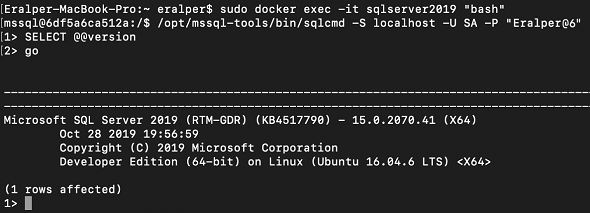

- #Docker mac sql server space for container how to
- #Docker mac sql server space for container install
- #Docker mac sql server space for container pro

These working copy versions are not compatible.Īlways use the version of TortoiseSVN which matches your app model. Previous versions of the Mendix Desktop Modeler used a Subversion 1.7 working copy.
#Docker mac sql server space for container pro
In one of my next blog postings I will then show you how you can actually deploy a SQL Server Big Data Cluster with this Docker Container.Mendix Studio Pro uses the Subversion 1.9 working copy. Unfortunately, there was a missing dependency to a shared object file which costed me some time until I found a solution for it. Running the necessary command line tools for a SQL Server Big Data Cluster in a Docker Container is not that easy, when you know what you have to do. libreadline6_6.3-8ubuntu2_bĪnd finally, everything is working as expected: The only workaround that I have found was the following: I downloaded that file from here, and copied it with the following command line into the Docker Container:ĭocker cp libreadline6_6.3-8ubuntu2_b bdc_tools:/libreadline6_6.3-8ubuntu2_bĪfter I have attached my terminal again against the Docker Container, I manually installed the. It seems that the shared object file libreadline.so.6 is missing in the Docker Container. Libreadline.so.6: cannot open shared object file: No such file or directory When I wanted to deploy a SQL Server Big Data Cluster, I got the following error message: It seems that everything is fine, but unfortunately this is not the case.
#Docker mac sql server space for container install
The next step is the installation of kubectl, so that you can manage your Kubernetes Cluster from the command line:Ĭurl -LO `curl -s `/bin/linux/amd64/kubectlĪfter I have installed kubectl, I had to import the context of my Azure Kubernetes Cluster into my local installation:Īz aks get-credentials -resource-group BDC_ResourceGroup -name bdc-clusterĪnd then I’m able to list my Kubernetes Worker Nodes:Īnd the final step is the installation of the azdata tool, with which you can manage your SQL Server Big Data Cluster:Īpt-get install gnupg ca-certificates curl wget software-properties-common apt-transport-https lsb-release -yĬurl -sL | gpg -dearmor | tee /etc/apt// > /dev/nullĪfter the installation, you can run azdata from the command line:

The next step is the installation of the Azure CLI, which can be done with the following command line:Īfter the installation of the Azure CLI, I have logged in into my Azure Subscription:Īfter the successful login, I’m able to list my Kubernetes Cluster, which is deployed into Azure: Creating and configuring the Docker Containerįirst of all, I have created a new Docker Container which is based on the Linux Ubuntu image:ĭocker run -t -name bdc_tools -i ubuntu /bin/bashĪfter I was logged into the newly created Docker Container, I have installed the tool curl: And finally, you also need the tool azdata, which is the main command line tool to manage your SQL Server Big Data Cluster. When you have a Kubernetes Cluster deployed into Azure, you can manage it locally with the kubectl command, which is the command line tool for Kubernetes. The Azure CLI is used to connect to and manage your Azure Subscription. To be able to deploy and manage a SQL Server Big Data Cluster from the command line, you need to have at least the following 3 tools installed:
#Docker mac sql server space for container how to
Therefore, I want to show you in today’s blog posting how to install the SQL Server Big Data Cluster Tools in a Docker Container. In the days of Docker, I don’t really like it have too many tools installed locally on my work machine, because I want to have them isolated in a Docker Container. Running a SQL Server Big Data Cluster is quite easy, because you can deploy it with a simple command into Azure Kubernetes Services.īut to be able to do that you need to have a few command line tools installed on your local machine. As you know from my last blog posting, I’m currently investing a lot of my time into Big Data technologies and especially into SQL Server Big Data Clusters.


 0 kommentar(er)
0 kommentar(er)
